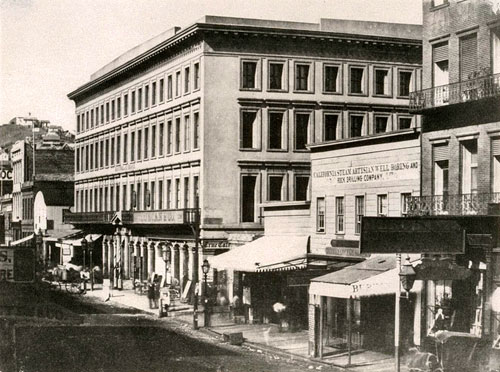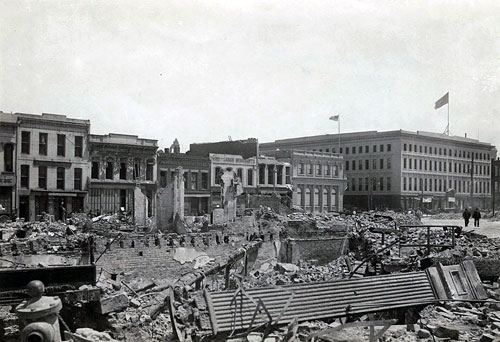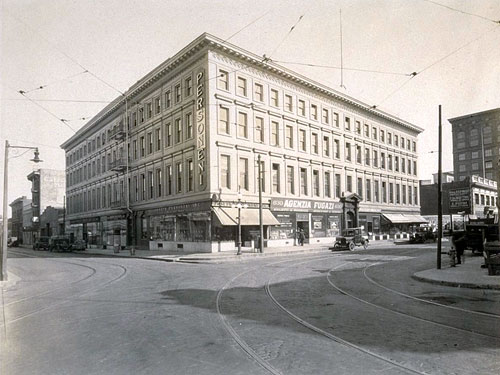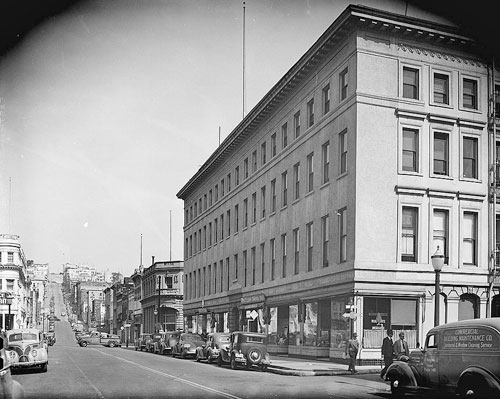California Historical Landmarks in San Francisco
California Historical Landmark 80
Site of the Montgomery Block
600 Montgomery Street
Built 1853
Demolished 1959
Replaced by Transamerica Pyramid
Plaque in Lobby of Transamerica Pyramid
This is the site of San Francisco's first fireproof building, erected in 1853 by Henry Wager Halleck. It was the headquarters for many outstanding lawyers, financiers, writers, actors, and artists. James King of William, editor of the Bulletin, died here on May 14, 1856 after being shot by James Casey. This building escaped destruction in the fire of 1906.
Citation from California Office of Historic Preservation

From Historic American Building Survey

Though it is now one of the most recognized buildings in the world, the Transamerica Pyramid at its inception 30 years ago was one of the most controversial and most vilified. Hailed by its fans as the world's first modern pyramid when it poked into the sky in 1972, the building was branded by critics, as one Examiner magazine writer put it, "the most portentously and insidiously bad building in The City." Another called it antisocial architecture at its worst.... The Chronicle's Pulitzer Prize-winning architectural critic, Allan Temko, called it an abomination, and still believes that....
The building and the neighborhood have a colorful history.... The block on which the Pyramid sits, bounded by Montgomery, Washington, Clay and Sansome streets, long been the heart of San Francisco's Financial District. Besides that prosaic designation, the area has had more colorful names - the Montgomery Block and the Monkey Block being the most prominent. The part of Merchant Street that was obliterated by the Pyramid once was called Fish Alley, an extension of the open air market that once dominated that part of town.
Artists, poets and writers lived there into the 1950s in something called "Halleck's Folly," a strange architectural landmark built by architect Henry Wager "Old Brains" Halleck. When it was built in 1853, it was described as the grandest building west of St. Louis. Before the early-day bohemians moved in, it was a bank exchange. Newspaper editor James King of William was murdered there and Sun Yat-sen plotted the overthrow of China's Manchu dynasty in one of the Folly's rooms....
The critics who warned of a forest of skyscrapers being inspired by the Pyramid were right. What once was one of The City's most colorful neighborhoods is now filled with highrises, most of them, critics say, with less architectural distinction than the Pyramid. Along with the long-vanished produce and fish market, gone, too, are such venerable San Francisco landmarks as the Blue Fox, Black Cat, Purple Onion, Iron Pot, Pietro's, the Hall of Justice, Bea and Ray Goman's Gay '90s, Earthquake McGoon's, where Turk Murphy and his band played, and the Barbary Coast international settlement.
By Larry D. Hatfield writing in the San Francisco Examiner dated 18 February 1999.


Photograph and caption courtesy of UC Berkeley, Bancroft Library.


Photo Courtesy of UC Berkeley, Bancroft Library
The buildings in the 700 block survived both the Earthquake and the midcentury redevelopment which demolished the Montgomery Block. The surviving buildings are included in the Jackson Square Historic District.
The rubble in the foreground was cleared, and in 1909 the Fugazi Bank Building was built on the triangular parcel bounded by Montgomery Street and Columbus Avenue.


Courtesy of UC Berkeley, Bancroft Library



Points of historical interest associated with Portsmouth Plaza and Gold Rush San Francisco:
- California Star Newspaper Site
- Clay Street Hill Railroad Site
- First American Flag Raised in San Francisco
- First Public School in California
- First United States Branch Mint
- Jackson Square Historic District
- Jenny Lind Theatre and San Francisco City Hall Site
- Montgomery Block Site
- Pony Express Site
- Portsmouth Plaza
- Robert Louis Stevenson Remembrance